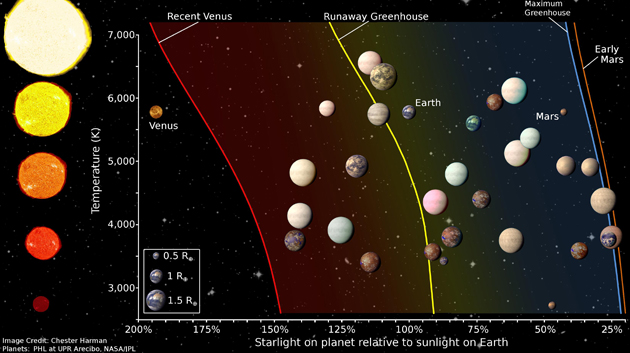

A team of astronomers known as the Kepler Habitable Zone Working Group, including University of Hawaiʻi at Mānoa Institute for Astronomy astronomer Nader Haghighipour, has identified which of the more than 4,000 exoplanets discovered by the NASA Kepler mission are most likely to be similar to our rocky home.
The research describes 49 Kepler-discovered planets with radii smaller than twice that of Earth (a criterion for the planet to be rocky) located within the habitable zones of their host stars—an area around a star where a rocky planet can maintain liquid water on its surface. Of these planets, 20 are excellent candidates for habitable rocky planets similar to Earth. The work is detailed in the article “A catalog of Kepler habitable zone exoplanet candidates” for Astrophysical Journal led by Stephen Kane of San Francisco University.
“After more than 3 years analyzing Kepler data, we have created the most complete catalog of Kepler Habitable Zone planets, with the largest number of rocky planets that could potentially harbor life,” said Haghighipour. The list contains a total of 216 planets with different sizes, some much larger than Earth.
Universe teeming with planets where life could potentially exist
The research also confirms that the distribution of Kepler planet sizes within the habitable zone is the same as the distribution of those outside of it.
“Given that many of these planets are as large as gas-giant planets in our solar system, there is a high possibility that these planets may harbor large moons that could also be habitable,” said Haghighipour. The latter, combined with the similarity between the distribution of planets inside and outside of the habitable zones presents strong evidence that the universe is teeming with planets and moons where life could potentially exist.
The boundaries of the habitable zone are critical. If a planet is too close to its star, it will experience a runaway greenhouse gas effect, like Venus. But if it’s too far, any water will freeze, as is seen on Mars. The team sorted the planets by whether they were in a conservative or a more optimistic interpretation of the habitable zone. Then they further sorted them by planet size: smaller, rocky planets versus larger gas giants.
These categories will help astronomers focus their research. Those looking for moons that could potentially hold life can study exoplanets in the gas giant categories, for example.
The 20 planets in the most restrictive category—rocky surface and a conservative habitable zone—are the most likely to be similar to Earth. “These are the prime targets for our studies with large ground-based telescopes such as the Keck, Subaru and Gemini telescopes—and in the future, the Thirty Meter Telescope,” said Haghihgipour.

